钙钛矿量子点发光二极管.pdf
- 格式:pdf
- 大小:1.62 MB
- 文档页数:21
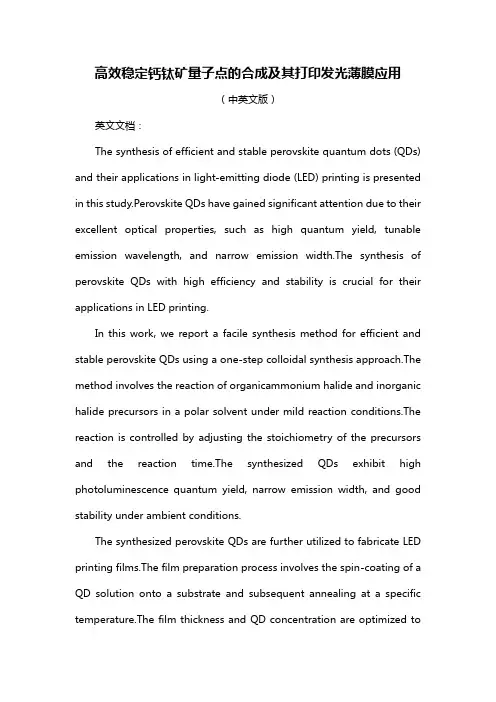
高效稳定钙钛矿量子点的合成及其打印发光薄膜应用(中英文版)英文文档:The synthesis of efficient and stable perovskite quantum dots (QDs) and their applications in light-emitting diode (LED) printing is presented in this study.Perovskite QDs have gained significant attention due to their excellent optical properties, such as high quantum yield, tunable emission wavelength, and narrow emission width.The synthesis of perovskite QDs with high efficiency and stability is crucial for their applications in LED printing.In this work, we report a facile synthesis method for efficient and stable perovskite QDs using a one-step colloidal synthesis approach.The method involves the reaction of organicammonium halide and inorganic halide precursors in a polar solvent under mild reaction conditions.The reaction is controlled by adjusting the stoichiometry of the precursors and the reaction time.The synthesized QDs exhibit high photoluminescence quantum yield, narrow emission width, and good stability under ambient conditions.The synthesized perovskite QDs are further utilized to fabricate LED printing films.The film preparation process involves the spin-coating of a QD solution onto a substrate and subsequent annealing at a specific temperature.The film thickness and QD concentration are optimized toachieve the desired optical properties.The resulting LED printing films exhibit efficient and stable electroluminescence with tunable emission wavelengths.The applications of the perovskite QD-based LED printing films are explored in various fields, including display technology, solid-state lighting, and optical communication systems.The efficient and stable emission properties of the films make them suitable candidates for high-performance LED devices.Overall, this study demonstrates a facile synthesis method for efficient and stable perovskite QDs and their applications in LED printing.The synthesized QDs and LED printing films offer promising prospects for future optoelectronic devices.中文文档:本研究介绍了高效稳定钙钛矿量子点(QDs)的合成及其在发光二极管(LED)打印发光薄膜应用。
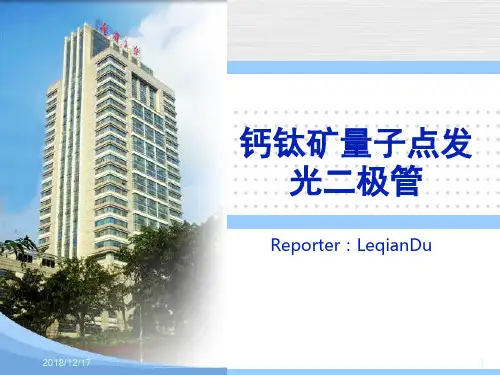
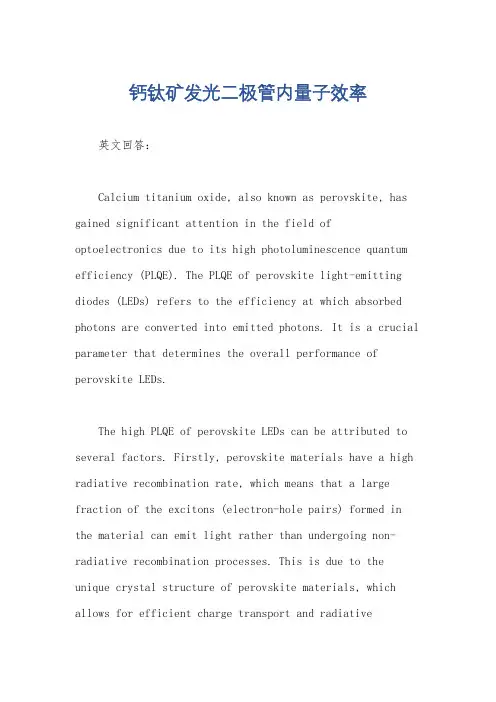
钙钛矿发光二极管内量子效率英文回答:Calcium titanium oxide, also known as perovskite, has gained significant attention in the field of optoelectronics due to its high photoluminescence quantum efficiency (PLQE). The PLQE of perovskite light-emitting diodes (LEDs) refers to the efficiency at which absorbed photons are converted into emitted photons. It is a crucial parameter that determines the overall performance of perovskite LEDs.The high PLQE of perovskite LEDs can be attributed to several factors. Firstly, perovskite materials have a high radiative recombination rate, which means that a large fraction of the excitons (electron-hole pairs) formed in the material can emit light rather than undergoing non-radiative recombination processes. This is due to the unique crystal structure of perovskite materials, which allows for efficient charge transport and radiativerecombination.Additionally, perovskite materials can exhibit a phenomenon called "carrier multiplication" or "multiple exciton generation". This occurs when a single absorbed photon generates multiple excitons, leading to an enhanced emission efficiency. This phenomenon is particularly advantageous for perovskite LEDs as it boosts the overall quantum efficiency of the device.Furthermore, the PLQE of perovskite LEDs can be improved through careful engineering of the devicestructure and interfaces. For example, the use of charge transport layers and optimized electrode materials can help to minimize non-radiative recombination and enhance radiative recombination. By reducing the losses associated with non-radiative processes, the PLQE can be significantly increased.In summary, the high PLQE of perovskite LEDs is aresult of the unique properties of perovskite materials, including their high radiative recombination rate and theability to exhibit carrier multiplication. Additionally, device engineering plays a crucial role in maximizing the PLQE by minimizing non-radiative losses.中文回答:钙钛矿(也称为钙钛矿)由于其高光致发光量子效率(PLQE),在光电子学领域引起了极大的关注。
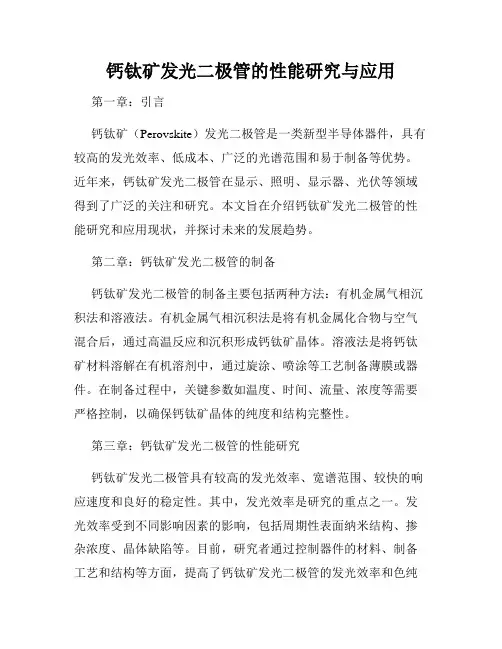
钙钛矿发光二极管的性能研究与应用第一章:引言钙钛矿(Perovskite)发光二极管是一类新型半导体器件,具有较高的发光效率、低成本、广泛的光谱范围和易于制备等优势。
近年来,钙钛矿发光二极管在显示、照明、显示器、光伏等领域得到了广泛的关注和研究。
本文旨在介绍钙钛矿发光二极管的性能研究和应用现状,并探讨未来的发展趋势。
第二章:钙钛矿发光二极管的制备钙钛矿发光二极管的制备主要包括两种方法:有机金属气相沉积法和溶液法。
有机金属气相沉积法是将有机金属化合物与空气混合后,通过高温反应和沉积形成钙钛矿晶体。
溶液法是将钙钛矿材料溶解在有机溶剂中,通过旋涂、喷涂等工艺制备薄膜或器件。
在制备过程中,关键参数如温度、时间、流量、浓度等需要严格控制,以确保钙钛矿晶体的纯度和结构完整性。
第三章:钙钛矿发光二极管的性能研究钙钛矿发光二极管具有较高的发光效率、宽谱范围、较快的响应速度和良好的稳定性。
其中,发光效率是研究的重点之一。
发光效率受到不同影响因素的影响,包括周期性表面纳米结构、掺杂浓度、晶体缺陷等。
目前,研究者通过控制器件的材料、制备工艺和结构等方面,提高了钙钛矿发光二极管的发光效率和色纯度。
另外,钙钛矿发光二极管在不同波段均能发光,因此可以实现全彩显示、白光照明等多种应用。
第四章:钙钛矿发光二极管的应用研究钙钛矿发光二极管的应用涉及照明、显示、显示器和光伏等领域。
在照明领域,钙钛矿发光二极管的高效发光特性使其成为一种更加环保、能源节约的照明源,被视为传统白光LED的最有利替代方案。
在显示领域,钙钛矿发光二极管具有宽色域、高亮度、高对比度等优点,可以实现更好的显示效果。
在显示器领域,钙钛矿发光二极管的快速响应和高稳定性使其受到越来越多的关注和使用。
在光伏领域,钙钛矿材料的光伏转换效率高,可以制备高效太阳能电池。
第五章:钙钛矿发光二极管的发展趋势随着钙钛矿发光二极管领域的深入研究,钙钛矿材料的制备工艺和性能已经得到了很大提高,这为其在各个领域的应用提供了广阔的前景。
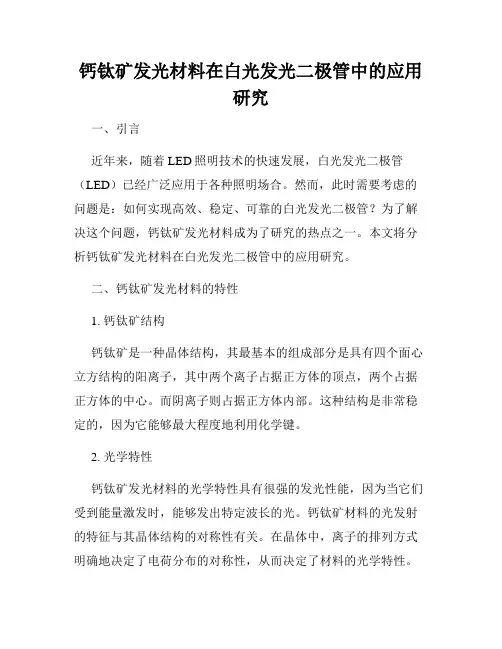
钙钛矿发光材料在白光发光二极管中的应用研究一、引言近年来,随着LED照明技术的快速发展,白光发光二极管(LED)已经广泛应用于各种照明场合。
然而,此时需要考虑的问题是:如何实现高效、稳定、可靠的白光发光二极管?为了解决这个问题,钙钛矿发光材料成为了研究的热点之一。
本文将分析钙钛矿发光材料在白光发光二极管中的应用研究。
二、钙钛矿发光材料的特性1. 钙钛矿结构钙钛矿是一种晶体结构,其最基本的组成部分是具有四个面心立方结构的阳离子,其中两个离子占据正方体的顶点,两个占据正方体的中心。
而阴离子则占据正方体内部。
这种结构是非常稳定的,因为它能够最大程度地利用化学键。
2. 光学特性钙钛矿发光材料的光学特性具有很强的发光性能,因为当它们受到能量激发时,能够发出特定波长的光。
钙钛矿材料的光发射的特征与其晶体结构的对称性有关。
在晶体中,离子的排列方式明确地决定了电荷分布的对称性,从而决定了材料的光学特性。
3. 发光机制钙钛矿材料的发光机制是由于材料受到能量激发从而发生跃迁,从而产生发光现象。
钙钛矿光谱的产生是由于3d能级的电子跃迁到4f能级上而产生的。
这种跃迁产生的发光光谱与晶体中电子的分布状态有关。
三、白光LED的发光机理白光LED是通过选择不同材料,将多种颜色的发光单元组合在一起,通过混合颜色的方式达到白光发射。
白光LED的核心是蓝色LED,通过用黄色荧光材料包覆蓝色LED来制造白光LED。
此外,在依据不同材料进行设计时,由于每个发光单元的波长不同,因此需要特殊设计,以最大程度地混合颜色。
四、钙钛矿发光材料在白光LED中的应用白光LED的构造过程相当复杂,但使用钙钛矿发光材料则使过程变得简单、创新和经济。
使用钙钛矿晶体作为LED的荧光体可以产生更高的稳定性和更高的照明效果。
钙钛矿发光材料是制造高效、可靠、稳定、明确颜色和光谱的白光LED的最佳选择。
1. 光谱特性优化使用钙钛矿发光材料可以优化白光LED的光谱特性。